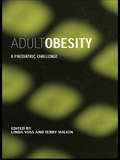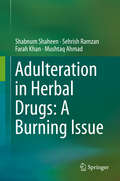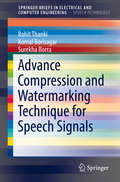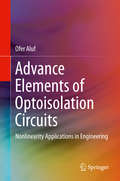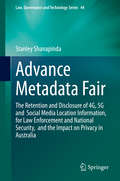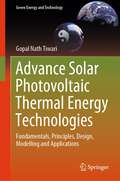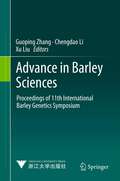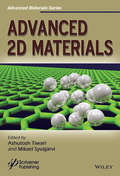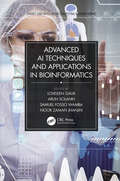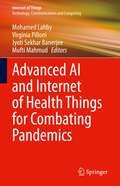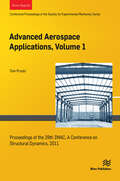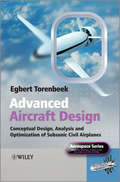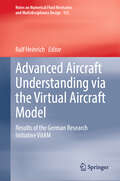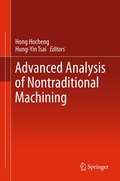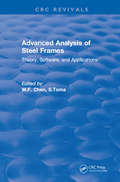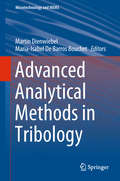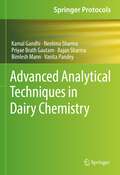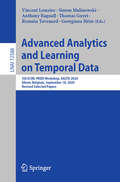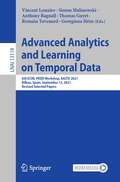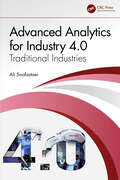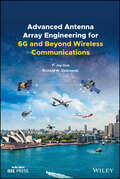- Table View
- List View
Adult Obesity: A Paediatric Challenge
by Linda D. Voss Terence J. WilkinWhile it is increasingly clear that adult obesity begins in childhood, preventing this condition is a major challenge for the pediatrician.Adult Obesity: A Paediatric Challenge highlights the causes and consequences of obesity, bringing a modern understanding to the treatment of a heavily stigmatized problem. This collection of essays, base
Adulteration in Herbal Drugs: A Burning Issue
by Mushtaq Ahmad Shabnum Shaheen Sehrish Ramzan Farah KhanSubstitution and adulteration in traded herbal raw material are common practice in the herbal industry due to the extinction of required species, deforestation and incorrect taxonomical identification. Herbalists have adopted methods to create high quality adulteration which cannot be detected without performing microscopic examination or chemical analysis. It is difficult to establish specific quality control standards due to the complex nature and innate unpredictability of the chemical constituents of medicinal herbs.The main parameters for measurement and adulteration prevention in medicinal herbs are morphological and microscopic investigation, chemical profiling and DNA barcoding. The need for highly sensitive and more effective approaches for the authentication of medicinal herbs is necessary in order to promote the acceptance of herbal products. Adulteration In Traditional Medicinal Herbs is aimed at promoting awareness of adulteration in traditional herbal medicines for the worldwide scientific community. Parameters are established for the prevention of adulteration through classical and modern scientific tools. Valuable case studies are presented based on ethno-medicinal surveys performed in many herbal markets in Pakistan. Collections of various samples were obtained from these shops then compared with the original plants collected from field. Various phytochemical, organoleptic and DNA barcoding techniques were used in order to detect adulteration in the marketed herbal samples. This book is the first of its kind and is aimed at helping the scientific community to identify particular medicinal plants which are facing adulteration problems in herbal markets and to estimate the extent of adulteration and substitution in commonly used medicinal herbs.
Advance Compression and Watermarking Technique for Speech Signals (SpringerBriefs in Speech Technology)
by Rohit Thanki Komal Borisagar Surekha BorraThis book introduces methods for copyright protection and compression for speech signals. The first method introduces copyright protection of speech signal using watermarking; the second introduces compression of the speech signal using Compressive Sensing (CS). Both methods are tested and analyzed. The speech watermarking method uses technology such as Finite Ridgelet Transform (FRT), Discrete Wavelet Transform (DWT) and Singular Value Decomposition (SVD). The performance of the method is evaluated and compared with existing watermarking methods. In the speech compression method, the standard Compressive Sensing (CS) process is used for compression of the speech signal. The performance of the proposed method is evaluated using various transform bases like Discrete Fourier Transform (DFT), Discrete Cosine Transform (DCT), Discrete Wavelet Transform (DWT), Singular Value Decomposition (SVD), and Fast Discrete Curvelet Transform (FDCuT).
Advance Concepts of Image Processing and Pattern Recognition: Effective Solution for Global Challenges (Transactions on Computer Systems and Networks)
by Krishna Kumar Narendra Kumar Celia Shahnaz Mazin Abed Mohammed Ram Shringar RawThe book explains the important concepts and principles of image processing to implement the algorithms and techniques to discover new problems and applications. It contains numerous fundamental and advanced image processing algorithms and pattern recognition techniques to illustrate the framework. It presents essential background theory, shape methods, texture about new methods, and techniques for image processing and pattern recognition. It maintains a good balance between a mathematical background and practical implementation. This book also contains the comparison table and images that are used to show the results of enhanced techniques. This book consists of novel concepts and hybrid methods for providing effective solutions for society. It also includes a detailed explanation of algorithms in various programming languages like MATLAB, Python, etc. The security features of image processing like image watermarking and image encryption etc. are also discussed in this book. This book will be useful for those who are working in the field of image processing, pattern recognition, and security for digital images. This book targets researchers, academicians, industry, and professionals from R&D organizations, and students, healthcare professionals working in the field of medical imaging, telemedicine, cybersecurity, data scientist, artificial intelligence, image processing, digital hospital, intelligent medicine.
Advance Elements of Laser Circuits and Systems: Nonlinear Applications in Engineering
by Ofer AlufThis book on Advance Elements of Laser circuits and systems Nonlinearity applications in engineering addresses two separate engineering and scientific areas, and presents advanced analysis methods for Laser circuits and systems that cover a broad range of engineering and scientific applications. The book analyzed Laser circuits and systems as linear and nonlinear dynamical systems and there limit cycles, bifurcation, and limit cycle stability by using nonlinear dynamic theory. Further, it discussed a broad range of bifurcations related to Laser systems and circuits, starting from laser system differential equations and their bifurcations, delay differential equations (DDEs) are a function of time delays, delay dependent parameters, followed by phase plane analysis, limit cycles and their bifurcations, chaos, iterated maps, period doubling. It combines graphical information with analytical analysis to effectively study the local stability of Laser systems models involving delay dependent parameters. Specifically, the stability of a given steady state is determined by the graphs of some functions of which can be expressed explicitly. The Laser circuits and systems are Laser diode circuits, MRI system Laser diode circuitry, Electron-photon exchanges into VCSEL, Ti: Sapphire laser systems, Ion channel and long-wavelength lasers, Solid state lasers, Solid state laser controlled by semiconductor devices, microchip solid-state laser, Q-switched diode-pumped solid-state laser, Nd:YAG, Mid-Infrared and Q-switched microchip lasers, Gas laser systems, copper vapor laser (CVL) circuitry, Dual-wavelength laser systems, Dual-wavelength operation of a Ti:sapphire laser, Diode-pumped Q-switched Nd:YVO4 yellow laser, Asymmetric dual quantum well lasers, Tm3+-doped silica fibre lasers, Terahertz dual-wavelength quantum cascade laser. The Book address also the additional areas, Laser X guiding system, Plasma diagnostics, Laser Beam shaping, Jitter and crosstalk, Plasma mirror systems, and High power Laser/Target diagnostic system optical elements. The book is unique in its emphasis on practical and innovative engineering and scientific applications. All conceptual Laser circuits are innovative and can be broadly implemented in many engineering applications. The dynamics of Laser circuits and systems provides several ways to use them in a variety of applications covering wide areas. This book is aimed at electrical and electronics engineers, students and researchers in physics as well. It is also aimed for research institutes in lasers and plasma physics and gives good comprehensive in laser and plasma systems. In each chapter, the concept is developed from basic assumptions up to the final engineering and scientific outcomes. The scientific background is explained at basic and advance levels and closely integrated with mathematical theory. Many examples are presented in this book and it is also ideal for intermediate level courses at graduate level studies. It is also ideal for engineer who has not had formal instruction in nonlinear dynamics, but who now desires to fill the gap between innovative Laser circuits/systems and advance mathematical analysis methods.
Advance Elements of Optoisolation Circuits: Nonlinearity Applications in Engineering
by Ofer AlufThis book on advanced optoisolation circuits for nonlinearity applications in engineering addresses two separate engineering and scientific areas, and presents advanced analysis methods for optoisolation circuits that cover a broad range of engineering applications. The book analyzes optoisolation circuits as linear and nonlinear dynamical systems and their limit cycles, bifurcation, and limit cycle stability by using Floquet theory. Further, it discusses a broad range of bifurcations related to optoisolation systems: cusp-catastrophe, Bautin bifurcation, Andronov-Hopf bifurcation, Bogdanov-Takens (BT) bifurcation, fold Hopf bifurcation, Hopf-Hopf bifurcation, Torus bifurcation (Neimark-Sacker bifurcation), and Saddle-loop or Homoclinic bifurcation. Floquet theory helps as to analyze advance optoisolation systems. Floquet theory is the study of the stability of linear periodic systems in continuous time. Another way to describe Floquet theory, it is the study of linear systems of differential equations with periodic coefficients. The optoisolation system displays a rich variety of dynamical behaviors including simple oscillations, quasi-periodicity, bi-stability between periodic states, complex periodic oscillations (including the mixed-mode type), and chaos. The route to chaos in this optoisolation system involves a torus attractor which becomes destabilized and breaks up into a fractal object, a strange attractor. The book is unique in its emphasis on practical and innovative engineering applications. These include optocouplers in a variety of topological structures, passive components, conservative elements, dissipative elements, active devices, etc. In each chapter, the concept is developed from the basic assumptions up to the final engineering outcomes. The scientific background is explained at basic and advanced levels and closely integrated with mathematical theory. The book is primarily intended for newcomers to linear and nonlinear dynamics and advanced optoisolation circuits, as well as electrical and electronic engineers, students and researchers in physics who read the first book "Optoisolation Circuits Nonlinearity Applications in Engineering". It is ideally suited for engineers who have had no formal instruction in nonlinear dynamics, but who now desire to bridge the gap between innovative optoisolation circuits and advanced mathematical analysis methods.
Advance Metadata Fair: The Retention and Disclosure of 4G, 5G and Social Media Location Information, for Law Enforcement and National Security, and the Impact on Privacy in Australia (Law, Governance and Technology Series #44)
by Stanley ShanapindaThis book outlines the legal powers of a major Western nation – Australia – to collect and use location information. Mobile service and social media service providers now have the ability to track, record and store more precise location information. Unlike 4G, 5G mobile communications require that cell towers and antennas be in much closer proximity; as a result, the location data can reveal more personal and sensitive information about individual citizens. Despite this aspect, service providers are required to disclose the data to the authorities, without the need for a judicial warrant. This book was written from the perspective of big location data software analytics, a capability that makes it possible to combine various location data points to create a profile on a given individual’s movements, habits, and political, religious and ideological orientation. In this regard, privacy is poorly protected. The rationale used to justify the powers was enforcing serious crimes – terrorism offences. Location data can now be retained for at least two years and be collected to investigate even minor offences. This can be done without the person being reasonably suspected of a criminal offence – when the individual is simply determined to be a person of interest. This poses legal risks to vulnerable communities. And yet, such investigative techniques are deemed lawful and reasonable. At a time when national security is so broadly defined to include economic issues, which in turn overlap with climate change and environmental protection, these legal powers should be reassessed. The book clarifies the complex rules that every citizen must know in order to have agency. Further, it calls upon authorities to reflect and to self-regulate, by making the conscious decision to surrender some of their powers to review by the independent judiciary. Without the requirement for a judicial warrant or judicial review, the powers are unfairly broad. The book pursues an interdisciplinary approach to assess the functionality of mobile telecommunications in direct relation to law enforcement powers and existing judicial precedents. Further, it offers a unifying techno-legal perspective on a complex issue touching on modern privacy law and communications technologies.
Advance Solar Photovoltaic Thermal Energy Technologies: Fundamentals, Principles, Design, Modelling and Applications (Green Energy and Technology)
by Gopal Nath TiwariThis book discusses topics such as solar energy, heat transfer, solar cell and photovoltaic module, greenhouse-integrated semi-transparent photovoltaic thermal (GiSPVT) system for agriculture and aquaculture, GiSPVT solar dryer, and PVT water and air collector for water heating, air heating, biogas heating and swimming pool heating, etc. The book also discusses energy matrices, including EPBT, EPF, and LCCE. It includes pedagogical elements such as exercises, tables, and figures including problems and objective questions at the end of each chapter. Further, it includes the unit conversion from FPS system to SI unit of each parameter, namely length, energy, power, velocity, pressure force, etc., and some standard constants used in examples. Quasi steady state and periodic modeling of PVT technology described in the book is a useful reference for students, researchers, and academicians to design solar energy-based technology.
Advance in Barley Sciences: Proceedings of 11th International Barley Genetics Symposium (Advanced Topics In Science And Technology In China Ser.)
by Chengdao Li Guoping Zhang Xu LiuAdvance in barley sciences presents the latest developments in barley sciences. It collects 39 papers submitted to the 11th International Barley Genetics Symposium, and covers all presentation sessions of the conference, i.e., barley development and economy, utilization of germplasm, genetic resources and genetic stocks, end-uses, biotic stress tolerance, abiotic stresses, new and renewed breeding methodology, barley physiology, breeding success stories, barley genomics and all other '-omics.' Th e information will be useful for barley breeders, brewers, biochemists, molecular geneticists and biotechnologists. Th is book may also serve as reference text for students and scientists engaged in barley research. Dr. Guoping Zhang is a barley breeder and crop physiologist at the Department of Agronomy, Zhejiang University, China. Dr. Chengdao Li is a senior molecular geneticist and barley breeder at the Department of Agriculture and Food, Western Australia, Australia. He is also an adjunct professor at Murdoch University of Australia and Zhejiang University. Dr. Xu Liu, a member of the China Academy of Engineering, is a plant resources researcher at the Chinese Academy of Agricultural Sciences.
Advanced 2D Materials
by Ashutosh Tiwari Mikael SyväjärviThis book brings together innovative methodologies and strategies adopted in the research and developments of Advanced 2D Materials. Well-known worldwide researchers deliberate subjects on (1) Synthesis, characterizations, modeling and properties, (2) State-of-the-art design and (3) innovative uses of 2D materials including: Two-dimensional layered gallium selenide Synthesis of 2D boron nitride nanosheets The effects of substrates on 2-D crystals Electrical conductivity and reflectivity of models of some 2D materials Graphene derivatives in semicrystalline polymer composites Graphene oxide based multifunctional composites Covalent and non-covalent polymer grafting of graphene oxide Graphene-semiconductor hybrid photocatalysts for solar fuels Graphene based sensors Graphene composites from bench to clinic Photocatalytic ZnO-graphene hybrids Hydroxyapatite-graphene bioceramics in orthopaedic applications
Advanced AI Techniques and Applications in Bioinformatics (Smart and Intelligent Computing in Engineering)
by Loveleen Gaur, Arun Solanki, Samuel Fosso Wamba and Noor Zaman JhanjhiThe advanced AI techniques are essential for resolving various problematic aspects emerging in the field of bioinformatics. This book covers the recent approaches in artificial intelligence and machine learning methods and their applications in Genome and Gene editing, cancer drug discovery classification, and the protein folding algorithms among others. Deep learning, which is widely used in image processing, is also applicable in bioinformatics as one of the most popular artificial intelligence approaches. The wide range of applications discussed in this book are an indispensable resource for computer scientists, engineers, biologists, mathematicians, physicians, and medical informaticists. Features: Focusses on the cross-disciplinary relation between computer science and biology and the role of machine learning methods in resolving complex problems in bioinformatics Provides a comprehensive and balanced blend of topics and applications using various advanced algorithms Presents cutting-edge research methodologies in the area of AI methods when applied to bioinformatics and innovative solutions Discusses the AI/ML techniques, their use, and their potential for use in common and future bioinformatics applications Includes recent achievements in AI and bioinformatics contributed by a global team of researchers
Advanced AI and Internet of Health Things for Combating Pandemics (Internet of Things)
by Mufti Mahmud Mohamed Lahby Jyoti Sekhar Banerjee Virginia PilloniThis book presents the latest research, theoretical methods, and novel applications in the field of Health 5.0. The authors focus on combating COVID-19 or other pandemics through facilitating various technological services. The authors discuss new models, practical solutions, and technological advances related to detecting and analyzing COVID-19 or other pandemic based on machine intelligence models and communication technologies. The aim of the coverage is to help decision-makers, managers, professionals, and researchers design new paradigms considering the unique opportunities associated with computational intelligence and Internet of Medical Things (IoMT). This book emphasizes the need to analyze all the information through studies and research carried out in the field of computational intelligence, communication networks, and presents the best solutions to combat COVID and other pandemics.
Advanced Aerospace Applications, Volume 1: Proceedings of the 29th IMAC, A Conference on Structural Dynamics, 2011
by Tom ProulxAdvanced Aerospace Applications, Volume 1. Proceedings of the 29th IMAC, A Conference and Exposition on Structural Dynamics, 2011, the first volume of six from the Conference, brings together 32 contributions to this important area of research and engineering. The collection presents early findings and case studies on fundamental and applied aspects of Structural Dynamics, including papers on Aeroelasticity, Ground Testing, Dynamic Testing of Aerospace Structures, and Random Vibration.
Advanced Aircraft Design
by Egbert TorenbeekAlthough the overall appearance of modern airliners has not changed a lot since the introduction of jetliners in the 1950s, their safety, efficiency and environmental friendliness have improved considerably. Main contributors to this have been gas turbine engine technology, advanced materials, computational aerodynamics, advanced structural analysis and on-board systems. Since aircraft design became a highly multidisciplinary activity, the development of multidisciplinary optimization (MDO) has become a popular new discipline. Despite this, the application of MDO during the conceptual design phase is not yet widespread.Advanced Aircraft Design: Conceptual Design, Analysis and Optimization of Subsonic Civil Airplanes presents a quasi-analytical optimization approach based on a concise set of sizing equations. Objectives are aerodynamic efficiency, mission fuel, empty weight and maximum takeoff weight. Independent design variables studied include design cruise altitude, wing area and span and thrust or power loading. Principal features of integrated concepts such as the blended wing and body and highly non-planar wings are also covered. The quasi-analytical approach enables designers to compare the results of high-fidelity MDO optimization with lower-fidelity methods which need far less computational effort. Another advantage to this approach is that it can provide answers to "what if" questions rapidly and with little computational cost.Key features:Presents a new fundamental vision on conceptual airplane design optimizationProvides an overview of advanced technologies for propulsion and reducing aerodynamic dragOffers insight into the derivation of design sensitivity informationEmphasizes design based on first principlesConsiders pros and cons of innovative configurationsReconsiders optimum cruise performance at transonic Mach numbersAdvanced Aircraft Design: Conceptual Design, Analysis and Optimization of Subsonic Civil Airplanes advances understanding of the initial optimization of civil airplanes and is a must-have reference for aerospace engineering students, applied researchers, aircraft design engineers and analysts.
Advanced Aircraft Flight Performance
by Antonio FilipponeThis book discusses aircraft flight performance, focusing on commercial aircraft but also considering examples of high-performance military aircraft. The framework is a multidisciplinary engineering analysis, fully supported by flight simulation, with software validation at several levels. The book covers topics such as geometrical configurations, configuration aerodynamics and determination of aerodynamic derivatives, weight engineering, propulsion systems (gas turbine engines and propellers), aircraft trim, flight envelopes, mission analysis, trajectory optimisation, aircraft noise, noise trajectories and analysis of environmental performance. A unique feature of this book is the discussion and analysis of the environmental performance of the aircraft, focusing on topics such as aircraft noise and carbon dioxide emissions.
Advanced Aircraft Understanding via the Virtual Aircraft Model: Results of the German Research Initiative VitAM (Notes on Numerical Fluid Mechanics and Multidisciplinary Design #155)
by Ralf HeinrichThis book reports on the results of a four-year collaborative project between the German Aerospace Center (DLR), three German universities and the aircraft industry. The project was funded by the Ministry for Economic Affairs and Climate Action. In the book, different subprojects are presented, with their corresponding case studies. Readers will find extensive information on simulation strategies required for virtual flight testing, and verification and validation aspects. All in all, this book offers a timely update on the state-of-the-art in flow simulation techniques, flight mechanics methods, integrated multidisciplinary simulation, reduced-order models, and on the development of processes for automated generation of aerodynamic databases. It addresses both researchers and professionals in the field of aviation engineering.
Advanced Analysis of Nontraditional Machining
by Hong Hocheng Hung-Yin TsaiNontraditional machining utilizes thermal, chemical, electrical, mechanical and optimal sources of energy to bind, form and cut materials. Advanced Analysis of Nontraditional Machining explains in-depth how each of these advanced machining processes work, their machining system components, and process variables and industrial applications, thereby offering advanced knowledge and scientific insight. This book also documents the latest and frequently cited research results of a few key nonconventional machining processes for the most concerned topics in industrial applications, such as laser machining, electrical discharge machining, electropolishing of die and mold, and wafer processing for integrated circuit manufacturing.
Advanced Analysis of Steel Frames: Theory, Software, and Applications
by W.F. ChenThe development of the limit state approach to design in recent years has focused particular attention on two basic requirements: accurate information regarding the behavior of structures throughout the entire range of loading up to the ultimate strength, and simple practical procedures to enable engineers to assess this behavior. This book satisfies these requirements by providing practical analysis methods for the design of steel frames. The book contains a wide range of second-order analyses: from elastic to inelastic, rigid to semi-rigid connections, and simple plastic hinge method to sophisticated plastic-zone method. Computer programs for each analysis are provided in the form of a floppy disk for easy implementation. Sample problems are described and user's manuals are well documented for each program developed in the book.
Advanced Analytical Methods in Tribology (Microtechnology and MEMS)
by Martin Dienwiebel Maria-Isabel De Barros BouchetThis book presents the basics and methods of nanoscale analytical techniques for tribology field. It gives guidance to the application of mechanical, microstructural, chemical characterization methods and topography analysis of materials. It provides an overview of the of state-of-the-art for researchers and practitioners in the field of tribology. It shows different examples to the application of mechanical, microstructural, chemical characterization methods and topography analysis of materials. Friction and Wear phenomena are governed by complexe processes at the interface of sliding surfaces. For a detailed understanding of these phenomena many surface sensitive techniques have become available in recent years. The applied methods are atom probe tomography, in situ TEM, SERS, NEXAFS, in situ XPS, nanoindentation and in situ Raman spectroscopy. A survey of new related numerical calculations completes this book. This concerns ab-initio coupling, numerical calculations for mechanical aspects and density functional theory (DFT) to study chemical reactivity.
Advanced Analytical Techniques in Dairy Chemistry (Springer Protocols Handbooks)
by Rajan Sharma Kamal Gandhi Priyae Brath Gautam Bimlesh Mann Neelima Sharma Vanita PandeyThis book compiles the advanced analytical techniques used in Dairy Chemistry research. It begins with the basic laboratory techniques and progresses towards techniques like spectroscopy, membrane processes, Western blotting etc. It provides step-by-step protocols for easy reproduction. It also provides troubleshooting guides. This one-of-a-kind protocols book is specifically designed for techniques used in Dairy Science research. It discusses all the necessary steps in different techniques, starting from sample preparations, standardizations and safety measures. It discusses the different techniques in assessing the quality of milk and milk products especially concerning to adulteration. It also includes the techniques used in assessing the active components in functional foods. The book is meant for students and researchers working in the field of Dairy and Food science. It is also useful for experts in the Dairy Industry.
Advanced Analytics and Learning on Temporal Data: 5th ECML PKDD Workshop, AALTD 2020, Ghent, Belgium, September 18, 2020, Revised Selected Papers (Lecture Notes in Computer Science #12588)
by Vincent Lemaire Georgiana Ifrim Simon Malinowski Anthony Bagnall Thomas Guyet Romain TavenardThis book constitutes the refereed proceedings of the 4th ECML PKDD Workshop on Advanced Analytics and Learning on Temporal Data, AALTD 2019, held in Ghent, Belgium, in September 2020. The 15 full papers presented in this book were carefully reviewed and selected from 29 submissions. The selected papers are devoted to topics such as Temporal Data Clustering; Classification of Univariate and Multivariate Time Series; Early Classification of Temporal Data; Deep Learning and Learning Representations for Temporal Data; Modeling Temporal Dependencies; Advanced Forecasting and Prediction Models; Space-Temporal Statistical Analysis; Functional Data Analysis Methods; Temporal Data Streams; Interpretable Time-Series Analysis Methods; Dimensionality Reduction, Sparsity, Algorithmic Complexity and Big Data Challenge; and Bio-Informatics, Medical, Energy Consumption, Temporal Data.
Advanced Analytics and Learning on Temporal Data: 6th ECML PKDD Workshop, AALTD 2021, Bilbao, Spain, September 13, 2021, Revised Selected Papers (Lecture Notes in Computer Science #13114)
by Vincent Lemaire Georgiana Ifrim Simon Malinowski Anthony Bagnall Thomas Guyet Romain TavenardThis book constitutes the refereed proceedings of the 6th ECML PKDD Workshop on Advanced Analytics and Learning on Temporal Data, AALTD 2021, held during September 13-17, 2021. The workshop was planned to take place in Bilbao, Spain, but was held virtually due to the COVID-19 pandemic. The 12 full papers presented in this book were carefully reviewed and selected from 21 submissions. They focus on the following topics: Temporal Data Clustering; Classification of Univariate and Multivariate Time Series; Multivariate Time Series Co-clustering; Efficient Event Detection; Modeling Temporal Dependencies; Advanced Forecasting and Prediction Models; Cluster-based Forecasting; Explanation Methods for Time Series Classification; Multimodal Meta-Learning for Time Series Regression; and Multivariate Time Series Anomaly Detection.
Advanced Analytics for Industry 4.0: Traditional Industries
by Ali SoofastaeiThe evolution of modern technology has affected all the industry dimensions. Mother industries play a critical role in providing the precursor materials for other industries, and a small improvement in these can make a big change in others. This book covers the analytics revolution in Industry 4.0 for the mother industries, such as mining, oil and gas, and steel. It focuses on the use of advanced analytics and artificial intelligence to improve the business decisions aimed at increasing the quality and quantity of mother industries' products. It helps to design and implement their digital transformation strategies in these industries.Key Features: Provides a concise overview of state of the art for mother industries' executives and managers. Highlights and describes critical opportunity areas for industry operations optimization. Explains how to implement advanced data analytics through case studies and examples. Provides approaches and methods to improve data-driven decision-making. Brings experience and learning in digital transformation from adjacent sectors. This book is aimed at researchers, professionals, and graduate students in data science, manufacturing, automation, and computer engineering.
Advanced Analytics in Mining Engineering: Leverage Advanced Analytics in Mining Industry to Make Better Business Decisions
by Ali SoofastaeiIn this book, Dr. Soofastaei and his colleagues reveal how all mining managers can effectively deploy advanced analytics in their day-to-day operations- one business decision at a time.Most mining companies have a massive amount of data at their disposal. However, they cannot use the stored data in any meaningful way. The powerful new business tool-advanced analytics enables many mining companies to aggressively leverage their data in key business decisions and processes with impressive results.From statistical analysis to machine learning and artificial intelligence, the authors show how many analytical tools can improve decisions about everything in the mine value chain, from exploration to marketing.Combining the science of advanced analytics with the mining industrial business solutions, introduce the “Advanced Analytics in Mining Engineering Book” as a practical road map and tools for unleashing the potential buried in your company’s data.The book is aimed at providing mining executives, managers, and research and development teams with an understanding of the business value and applicability of different analytic approaches and helping data analytics leads by giving them a business framework in which to assess the value, cost, and risk of potential analytical solutions. In addition, the book will provide the next generation of miners – undergraduate and graduate IT and mining engineering students – with an understanding of data analytics applied to the mining industry. By providing a book with chapters structured in line with the mining value chain, we will provide a clear, enterprise-level view of where and how advanced data analytics can best be applied. This book highlights the potential to interconnect activities in the mining enterprise better. Furthermore, the book explores the opportunities for optimization and increased productivity offered by better interoperability along the mining value chain – in line with the emerging vision of creating a digital mine with much-enhanced capabilities for modeling, simulation, and the use of digital twins – in line with leading “digital” industries.
Advanced Antenna Array Engineering for 6G and Beyond Wireless Communications
by Richard W. Ziolkowski Yingjie Jay GuoAdvanced Antenna Array Engineering for 6G and Beyond Wireless Communications Reviews advances in the design and deployment of antenna arrays for future generations of wireless communication systems, offering new solutions for the telecommunications industry Advanced Antenna Array Engineering for 6G and Beyond Wireless Communications addresses the challenges in designing and deploying antennas and antenna arrays which deliver 6G and beyond performance with high energy efficiency and possess the capability of being immune to interference caused by different systems mounted on the same platforms. This timely and authoritative volume presents innovative solutions for developing integrated communications networks of high-gain, individually-scannable, multi-beam antennas that are reconfigurable and conformable to all platforms, thus enabling the evolving integrated land, air and space communications networks. The text begins with an up-to-date discussion of the engineering issues facing future wireless communications systems, followed by a detailed discussion of different beamforming networks for multi-beam antennas. Subsequent chapters address problems of 4G/5G antenna collocation, discuss differentially-fed antenna arrays, explore conformal transmit arrays for airborne platforms, and present latest results on fixed frequency beam scanning leaky wave antennas as well as various analogue beam synthesizing strategies. Based primarily on the authors’ extensive work in the field, including original research never before published, this important new volume: Reviews multi-beam feed networks, array decoupling and de-scattering methods Provides a systematic study on differentially fed antenna arrays that are resistant to interference caused by future multifunctional/multi-generation systems Features previously unpublished material on conformal transmit arrays based on Huygen’s metasufaces and reconfigurable leaky wave antennas Includes novel algorithms for synthesizing and optimizing thinned massive arrays, conformal arrays, frequency invariant arrays, and other future arrays Advanced Antenna Array Engineering for 6G and Beyond Wireless Communications is an invaluable resource for antenna engineers and researchers, as well as graduate and senior undergraduate students in the field.
